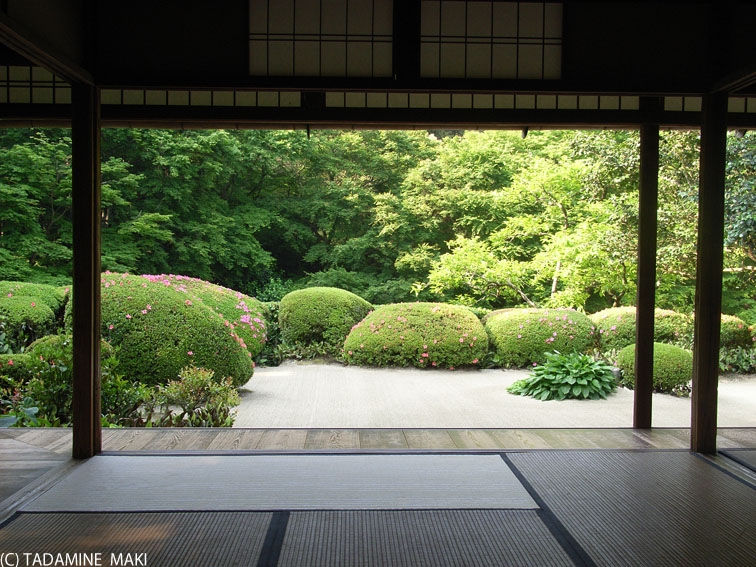Typical Japanese Garden
Points of View
(1)An immense scaled garden
(2)Exquisite maintenance
(3)The change of seasons
This building is famous for the mild atmosphere in its garden. White sand covers the surface of the ground, and well-maintained azaleas and maple trees are planted there. The greatest fascination is that the garden brings a feeling of relaxation. It is not so big and consists only of ordinary natural materials (unlike the Katsura Imperial Villa). Walking inside the site, the mild atmosphere surrounds you. Now, let’s go to the garden.
After a few minutes spent walking up the gentle slope from the bus stop, you arrive at the site. Seen from the outside, simple bamboo fences the site, and a small rustic gate welcomes you. A few mild stone stairs can be seen through the opening of the gate, and they draw you pleasantly in.
Going through the gate and up the stairs, you pass along a straight walkway to the building. The path, as well as the gate, is simple and narrow. The middle of the path is paved, and is just less than a meter wide. A sheet of white sand covers the ground closely along both sides of the pavement. The path is also fenced with low bamboo, while trees and bamboo grow over the fence. This vegetation largely shuts out the sunlight, and the light that does get through falls softly onto the ground. Every morning the path, as well as the garden, is immaculately cleaned. The surface is not only swept using bamboo brooms, but is also lightly marked with striped patterns which add a transitory beauty and lead the visitor to the realm of purity and tranquility.
As soon as you walk along the path, you glimpse the building over low hedges before arriving. Entering the building, you sit on tatami mats as a place for viewing the garden. The ground outside is covered with a sheet of white sand, while spherically trimmed azaleas and maple trees grow there. The tree-covered hillside outside the garden functions as borrowed scenery. A scattering of the vivid pink of azaleas in spring and the yellow and red of maple leaves in autumn means that it is beautiful throughout the year. The surface of the garden is also raked with stripes, and the azalea shrubbery is trimmed so as not to obstruct the view outside the garden from the building.
Going outside, visitors can walk in the garden, passing along another narrow path enclosed by stone walls and bamboo fences to access it. The garden is roughly composed of an upper and a lower part. From the building, only the upper part can be seen. The lower part has a small pond that cannot be seen from the building because of the azaleas, and it is fed by a brook leading to a stream outside. Many kinds of vegetation are arranged considering the size of the garden, so that people can enjoy the change of seasons.
The garden seen from the veranda looks neat but not simple, as raked sand, azaleas, maple trees and the surrounding elements of nature are well arranged in the picture frame formed by the columns and thresholds. The spotless ground and exquisite maintenance of the vegetation also add to the feeling of neatness.
The primary characteristic of Japanese gardens is their purity. Many famous gardens in Japan are invariably well-maintained, and early in the morning there are no leaves or litter on their paths or in their grounds. The most important factor in making a Japanese garden is purity, rather than the kinds of vegetation, the placement of the pond or the choice selection of stones. Even if the pond, trees and stones were arranged and selected perfectly, a lower level of maintenance would cause a deterioration in the garden. Originally, the importance of cleanliness comes from the characters of Japanese domestic deities and Zen. The nature of cleanliness is rather hard to appreciate, but it is indispensable to the beauty of Japanese gardens in the way that umami, a flavor contained in soup stock, is indispensable to Japanese cuisine.

This design is steller! You certainly know how to keep a reader amused. Between your wit and your videos, I was almost moved to start my own blog (well, almost…HaHa!) Fantastic job. I really enjoyed what you had to say, and more than that, how you presented it. Too cool!